Over the past year, I’ve spent more than six months traveling and living in Thailand. From Chiang Mai’s cool northern air to the southern charm of Hat Yai and Koh Lanta, Thai cuisine was the constant thread tying everything together. Each region had its own flavor, and each dish told a different story.
If you’re heading to Thailand and wondering what to eat (besides mango sticky rice on repeat guilty), you’re in for a real treat. Thai food is a full-on flavor explosion: sweet, spicy, sour, salty, and somehow comforting and bold at the same time. From spicy street food to creamy curries, here are 11 authentic Thai dishes you have to try when you’re there.
1. Khao Soi – Northern Thai Curry Noodles
Khao Soi is a signature dish from Northern Thailand, especially Chiang Mai. This creamy coconut curry noodle soup combines soft and crispy egg noodles with tender chicken or beef, topped with pickled mustard greens, shallots, lime, and chili oil. This is the first Thai dish I fell deeply in love with.
- What makes it special: The flavor is rich and comforting. If you’ve ever tried Indonesian rendang, the deep curry notes might feel slightly familiar but here, they come in a slurpable noodle form.
- Best places: Northern Thailand, especially Chiang Mai and Pai.
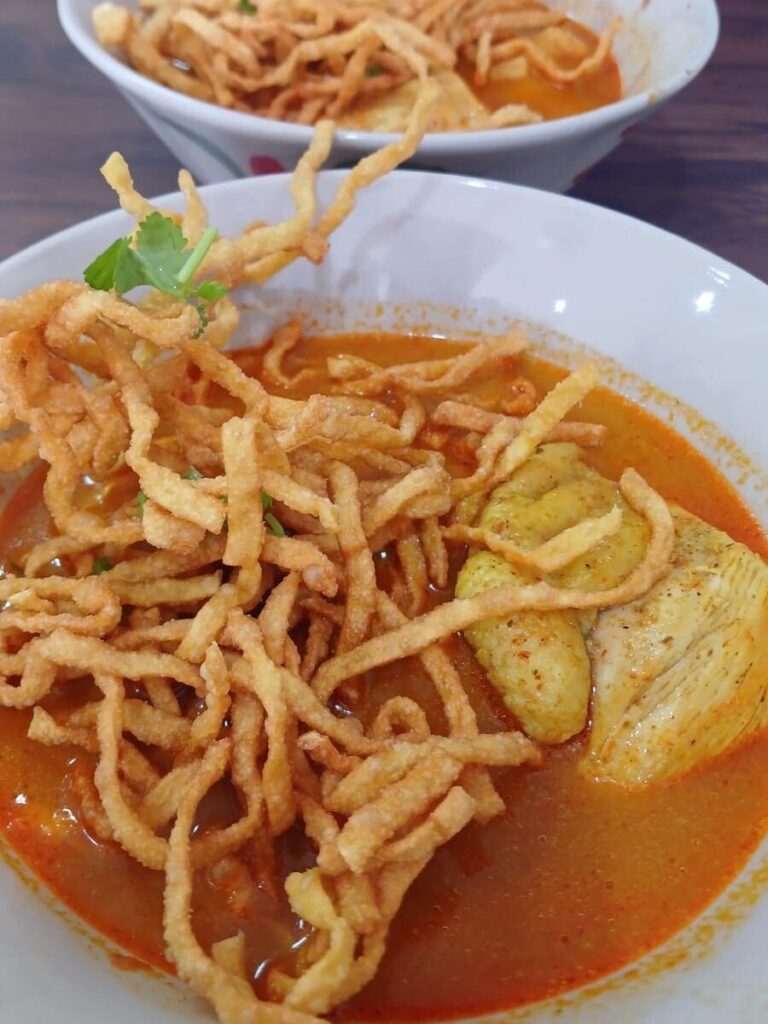
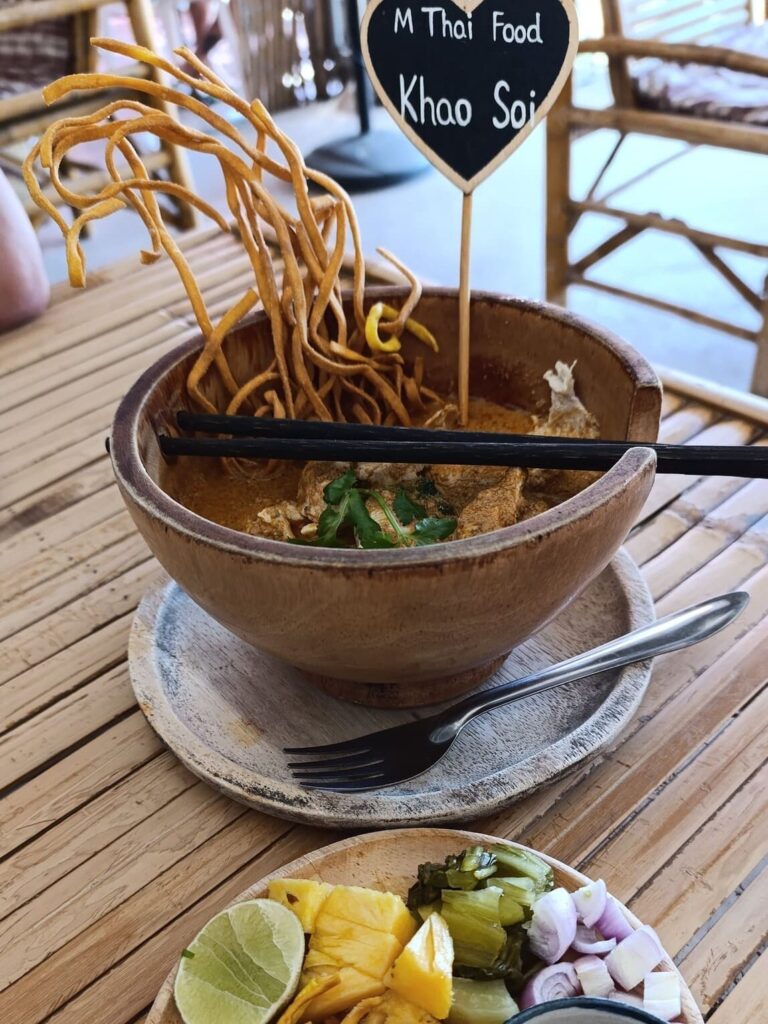
2. Pad Kra Pao – Thai Basil Stir-Fry
Pad Kra Pao is one of Thailand’s most popular everyday meals. It’s a stir-fry of minced pork, chicken, or beef with garlic, Thai chilies, and holy basil (krapao), served over rice with a fried egg (kai dao).
- Why I love it: It’s quick, spicy, affordable, and everywhere from Bangkok malls to small town food courts. As someone who needs rice every day, this was a go-to.
- Pro tip: Ask for “Pet nit noi” (a little spicy) if you’re sensitive to heat.
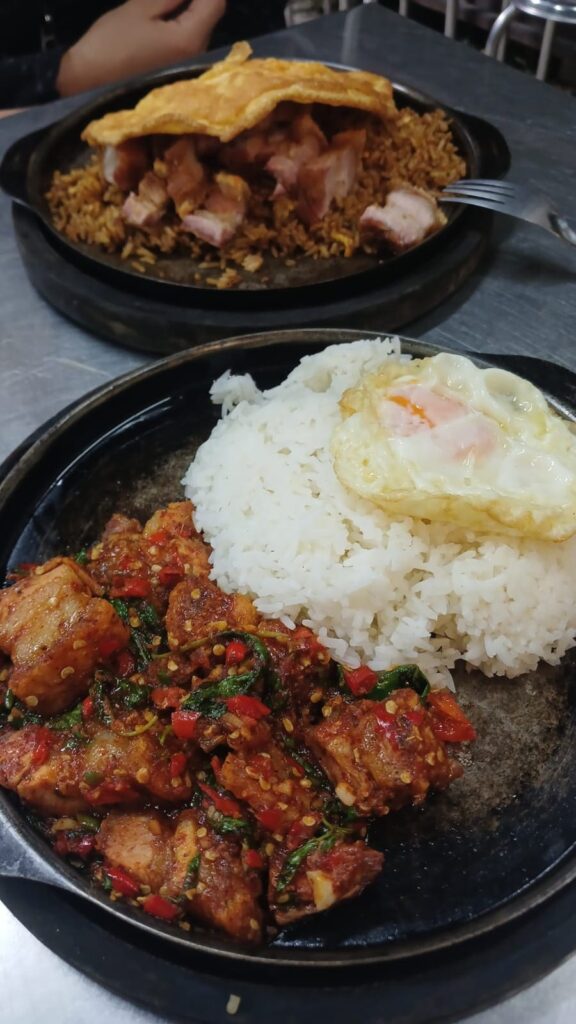
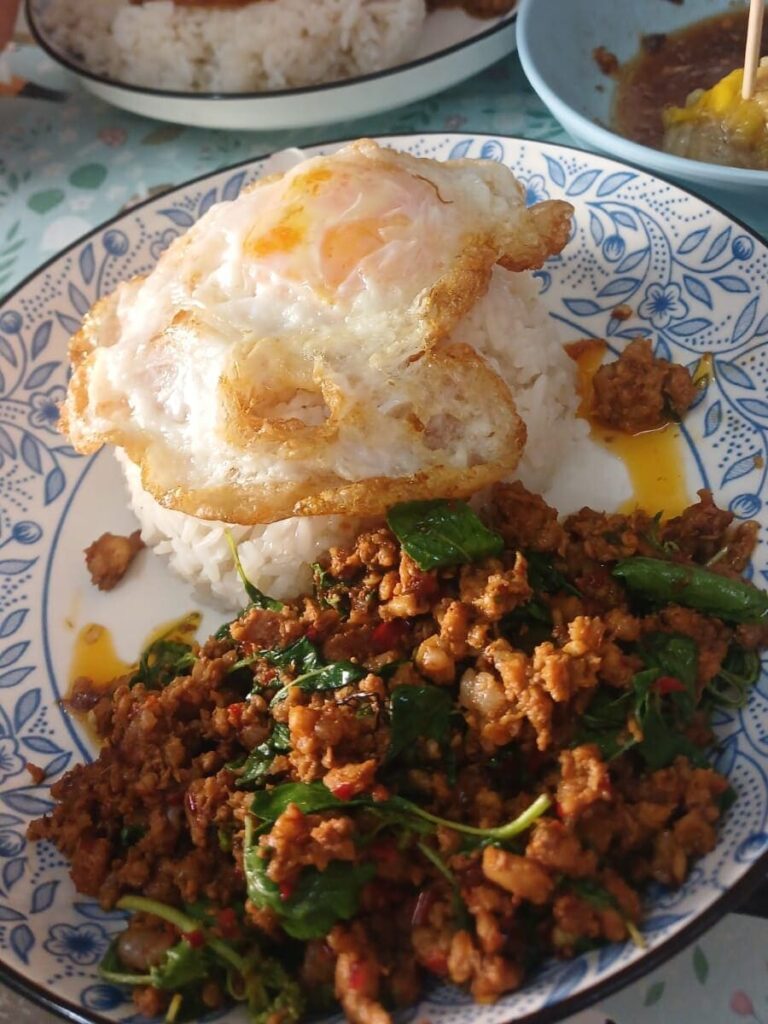
3. Pad Thai – Thailand’s Famous Stir-Fried Noodles
Pad Thai is Thailand’s best-known dish globally and for good reason. It’s a savory-sweet stir-fried noodle dish made with thin rice noodles, egg, tofu or shrimp, bean sprouts, garlic, tamarind paste, and palm sugar. Often served with crushed peanuts, lime wedges, and chili flakes on the side, it’s endlessly customizable and full of flavor.
- Why it’s a must-try: Pad Thai strikes a perfect balance of salty, sweet, tangy, and umami. Whether from a busy Bangkok street cart or a beach shack in Krabi, a good Pad Thai is comfort food at its finest.
What’s in a classic Pad Thai:
- Thin rice noodles
- Tamarind-based sauce (sweet and tangy)
- Egg, tofu, or shrimp
- Bean sprouts, chives
- Crushed peanuts, chili flakes, and lime on the side
Best places to try Pad Thai:
- Bangkok street food stalls (especially in old town areas like Banglamphu)
- Thip Samai in Bangkok (widely considered one of the best Pad Thai restaurants)
- Beach towns like Ao Nang, Koh Samui, and Phuket
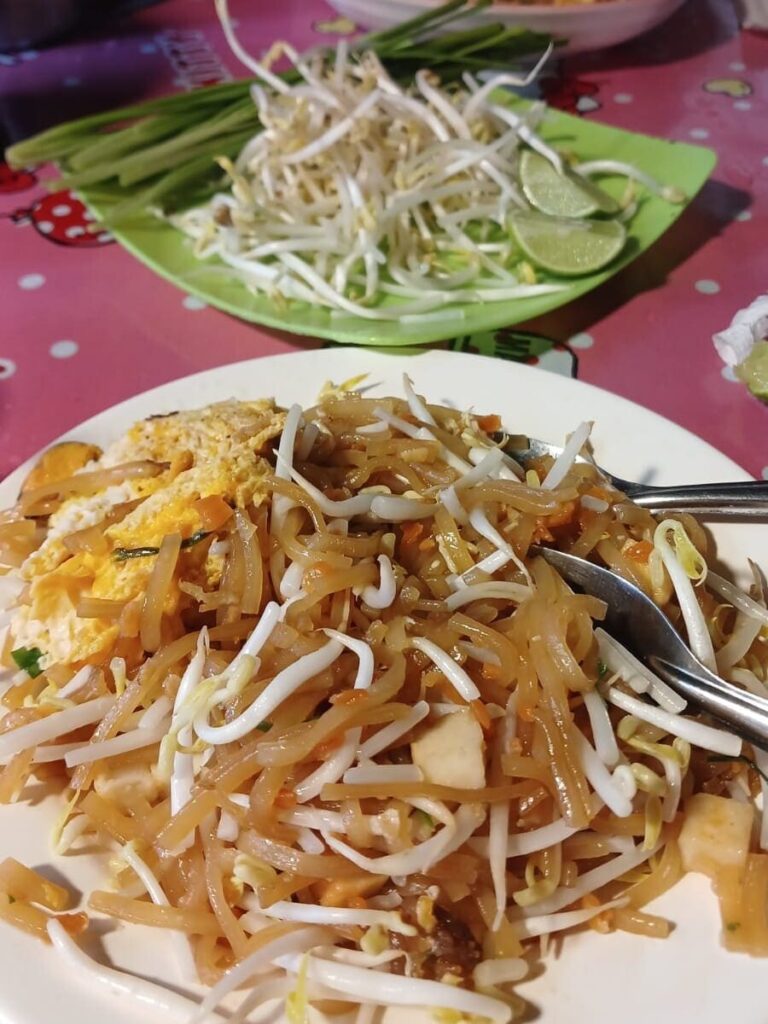
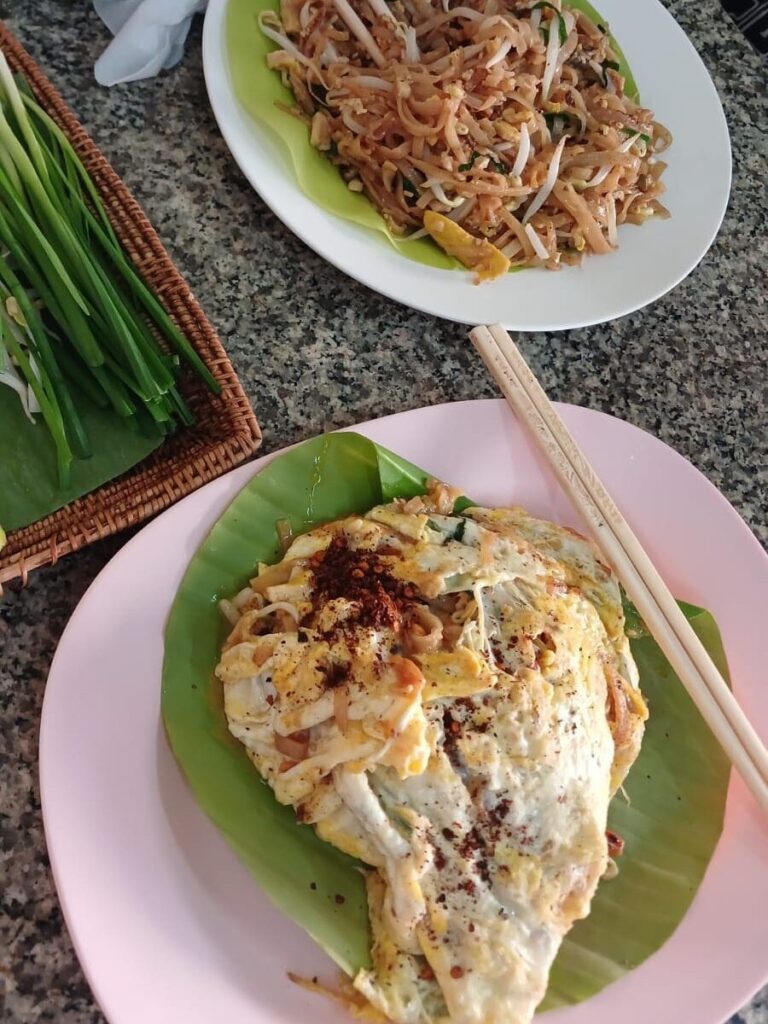
4. Pad See Ew – Soy Sauce Stir-Fried Noodles
Pad See Ew is made with wide rice noodles stir-fried in dark soy sauce with egg, Chinese broccoli, and your choice of protein (often chicken or pork). It’s slightly sweet, savory, and smoky from the high-heat wok cooking.
Tastes like: A Thai version of char kway teow (Malaysia) or chow fun (China), but with its own depth from Thai sauces and wok hei (smoky flavor).
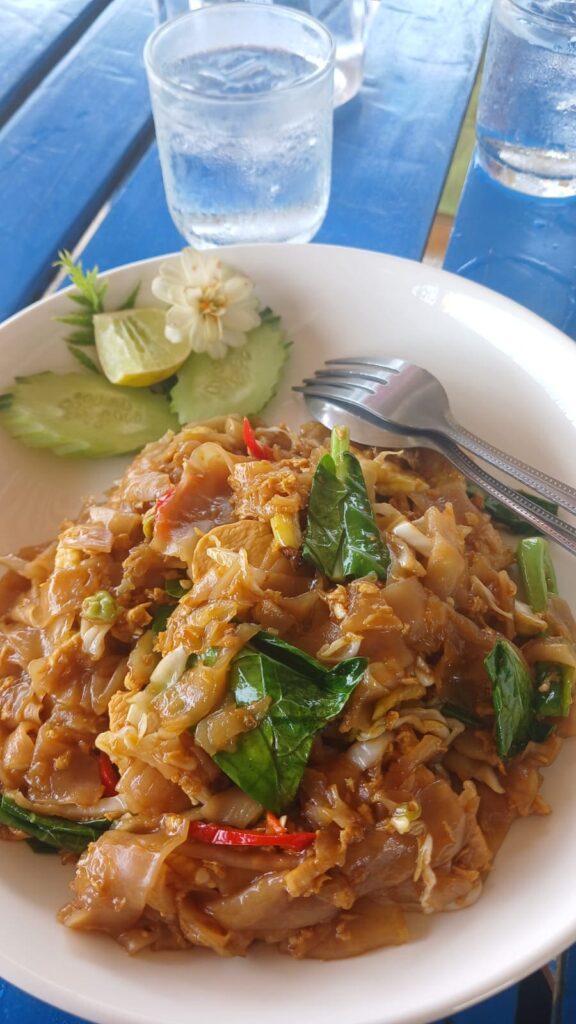
5. Panang Curry – Creamy Thai Curry with Peanuts
Panang curry is thicker and creamier than red or green curry. It’s usually made with chicken or beef, simmered in coconut milk, Panang curry paste, kaffir lime leaves, and crushed peanuts.
Flavor profile: Creamy, nutty, slightly sweet and aromatic. Less spicy than red curry, which makes it great for those new to Thai food.
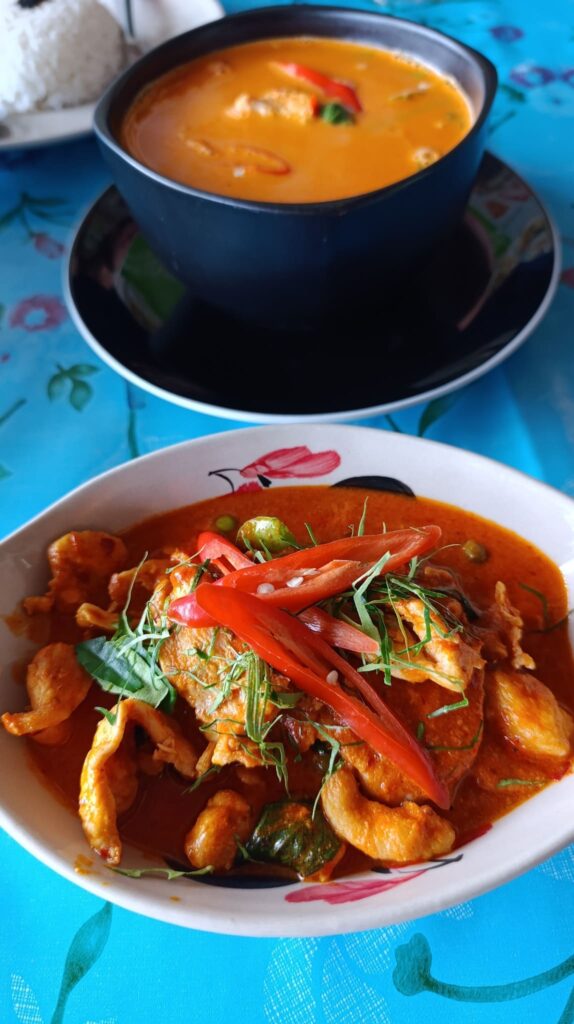
6. Red Curry – Spicy Coconut Milk Curry
Thai red curry is bold and aromatic. Made with red curry paste (chilies, garlic, lemongrass), it’s simmered in coconut milk with Thai eggplant, bamboo shoots, and meat or tofu.
Why it’s a must-try: It’s rich and spicy, but balanced with coconut milk. Best served over jasmine rice.
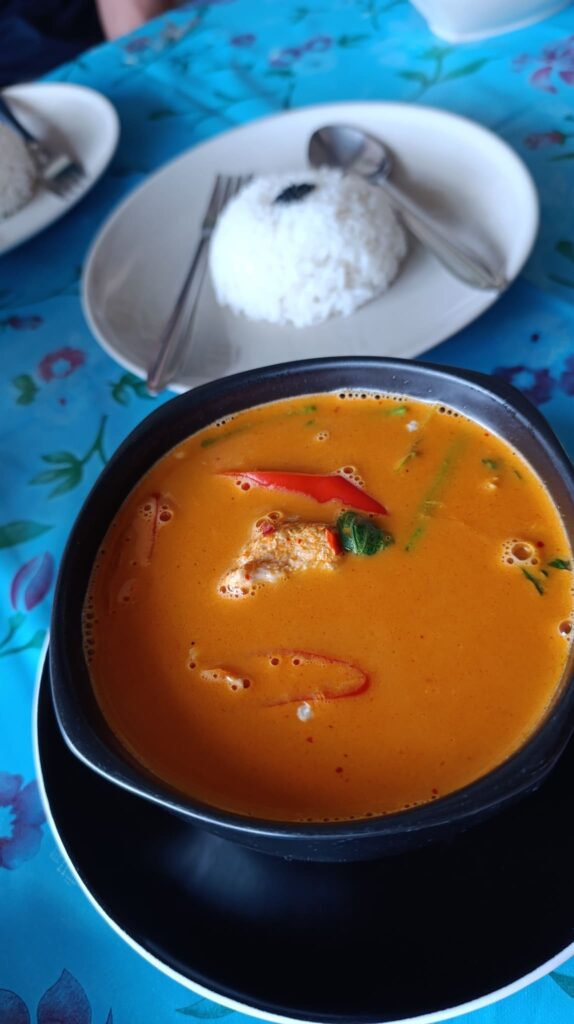
7. Green Curry – Herbal Thai Classic
Green curry gets its color from fresh green chilies. It’s often considered the most herbal and fragrant of the Thai curries.
- What’s inside: Green curry paste, coconut milk, Thai basil, eggplants, bamboo shoots, kaffir lime leaves, and your protein of choice.
- Tip: Eat it fresh, green curry can lose its brightness if overcooked.
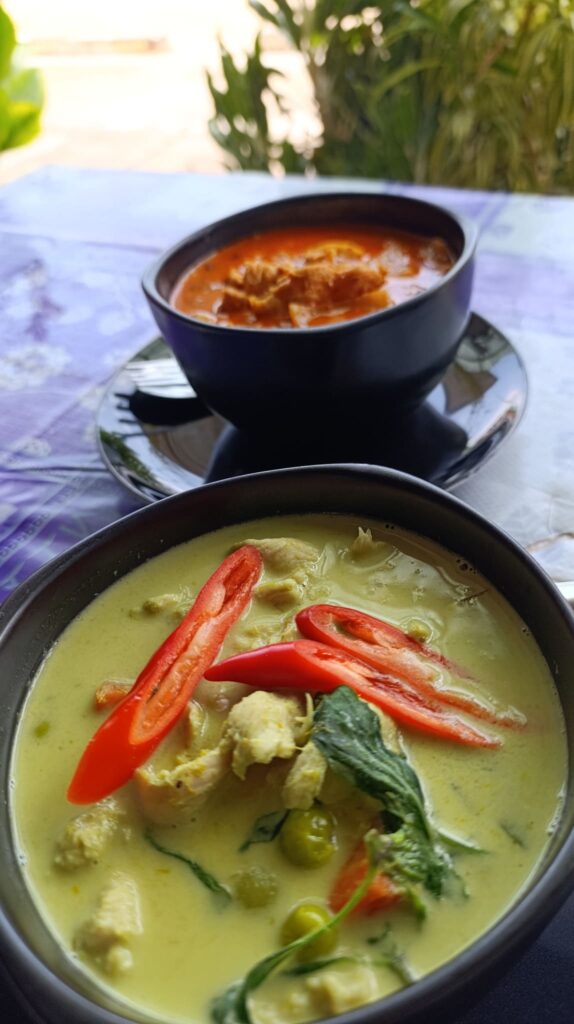
8. Thai Garlic Chicken – Simple and Crispy
Often overlooked, this dish is crispy, garlicky chicken seasoned with coriander root, black pepper, and fish sauce. It’s served with rice and sometimes a tangy dipping sauce.
Why it works: It’s simple but packed with flavor. A great non-spicy option that still delivers satisfaction.
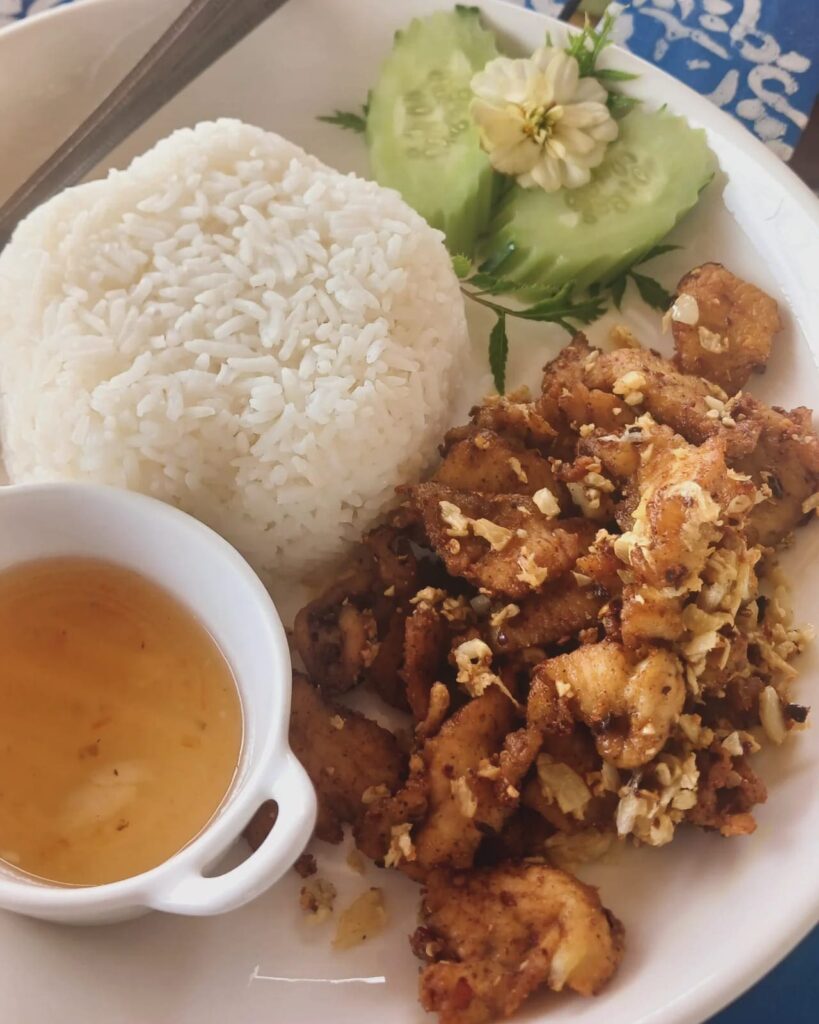
9. Som Tam – Spicy Green Papaya Salad
Som Tam is Thailand’s signature salad, made with shredded unripe papaya, chili, garlic, lime juice, fish sauce, palm sugar, tomatoes, and peanuts.
- Regional note: There are many variations, some with salted crab (Som Tam Poo), some with fermented fish (Pla Ra). Start with the classic before exploring!
- Why I crave it: It’s spicy, crunchy, sour, and fresh, all in one bite.
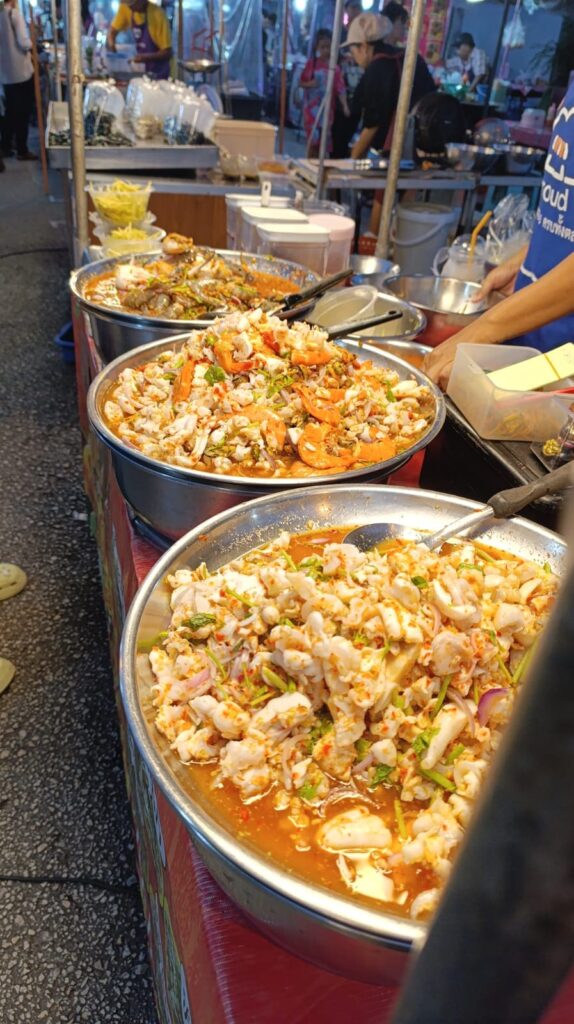
10. Tom Yum Goong – Spicy Thai Shrimp Soup
Tom Yum Goong is Thailand’s most iconic soup and a bold, spicy, sour, and aromatic masterpiece. It’s made with fresh shrimp, lemongrass, galangal, kaffir lime leaves, Thai chilies, mushrooms, and a dash of lime juice and fish sauce. You’ll often find it with a splash of evaporated milk or chili paste for extra richness.
Why it’s a must-try: Tom Yum is more than just soup, it’s an explosion of Thai flavor in liquid form. Hot, sour, and fragrant, it’s refreshing in a way that warms you up and cools you down at the same time.
What makes it special:
- Distinct herbal notes from lemongrass and galangal
- Signature sweet-sour-spicy balance
- Typically served with shrimp (goong), but variations with chicken (Tom Yum Gai) or seafood exist
Where to try it:
- Street food stalls and local restaurants across Thailand
- Floating markets or casual riverside eateries
- Most Thai homes serve it as a family staple
Tip: If you love spice and citrusy flavors, ask for “Tom Yum Nam Sai” (clear broth) for a punchier version, or try “Tom Yum Nam Khon” (creamy version) with added chili paste and milk.
11. Mango Sticky Rice – Thailand’s Famous Dessert
Made with sweet glutinous rice cooked in coconut milk, served with fresh mango and drizzled with salty-sweet coconut cream.
- When to eat: Best during mango season (March–May), but many places serve it year-round.
- Where I had the best one: A beach stall in Koh Lanta, after sunset. Perfectly ripe mango, warm rice, and creamy coconut, simple happiness.
Essential Tips for Eating Food in Thailand (with Thai Phrases)
Exploring Thai food is an adventure in itself. Here are some practical tips to help you enjoy authentic dishes like a local plus key Thai phrases you can use when ordering!
1. Know the Spice Levels
Thai food can be very spicy, especially in local eateries. Say this:
- “Pet nit noi” (เผ็ดนิดหน่อย) = A little spicy
- “Mai pet” (ไม่เผ็ด) = Not spicy
- “Pet mak” (เผ็ดมาก) = Very spicy
Tip: Even “a little spicy” can be hot by Western standards, start slow and build up!
2. Respect Local Eating Customs
- Spoon & Fork: Thais typically eat with a spoon (right hand) and a fork (left hand). Chopsticks are only used for noodle soups.
- No knives: Food is usually bite-sized already.
- Sharing is common: Dishes are served “family style,” so try ordering a few to share.
3. Try Street Food with Confidence
Thailand’s street food scene is safe, affordable, and often more flavorful than restaurants. Look for stalls with:
- High turnover
- Locals queuing
- Food cooked fresh to order
Tip: Start with dishes like Pad Kra Pao or Pad See Ew, they’re fast, safe, and delicious.
4. Practice These Helpful Thai Food Phrases
- “Aroi mak” (อร่อยมาก) = Very delicious!
- “Ao an-nee” (เอาอันนี้) = I’ll take this one
- “Check bin duay” (เช็คบิลด้วย) = The bill, please
- “Mai sai nam pla” (ไม่ใส่น้ำปลา) = No fish sauce (helpful for vegetarians)
- “Gin jay” (กินเจ) = I eat vegan (for Thai Buddhist vegetarian food)
5. Don’t Skip Condiments
Most Thai tables come with a condiment set including:
- Chili flakes (Phrik bon)
- Vinegar with chilies (Phrik nam som)
- Sugar
- Fish sauce (Nam pla)
Mix and match to balance sweet, salty, sour, and spicy, just like locals do!
6. Final Food Tip:
When in doubt, ask the locals what they recommend. Thais love talking about food and are usually happy to help. You might discover something not on any blog or menu.
Final Thoughts
Thai cuisine isn’t just food, it’s a cultural experience that reflects the country’s warmth, balance, and bold spirit. Whether you’re sampling street food in Bangkok, slurping Khao Soi in Chiang Mai, or enjoying Mango Sticky Rice by the beach, every dish tells a story.
These 11 must-try Thai foods represent the essence of Thailand’s culinary diversity. From fiery stir-fries to herbal curries and refreshing salads, there’s something for every palate, whether you love spice or prefer something mild and savory.
As you explore the flavors of Thailand:
- Be curious about what’s on the menu.
- Eat where locals eat often the best meals come from the humblest stalls.
- And above all, enjoy each bite slowly, soaking in the sights, smells, and sounds around you.
So go ahead, order that dish you’ve never heard of, say “Aroi mak!” when it’s delicious, and let Thai food guide you deeper into the country’s heart.
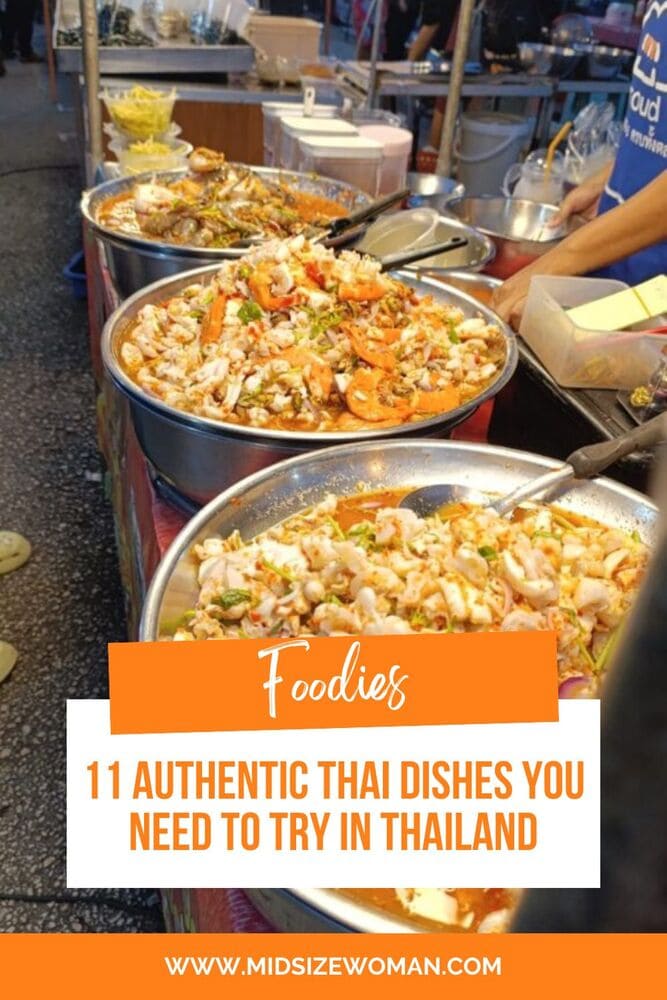
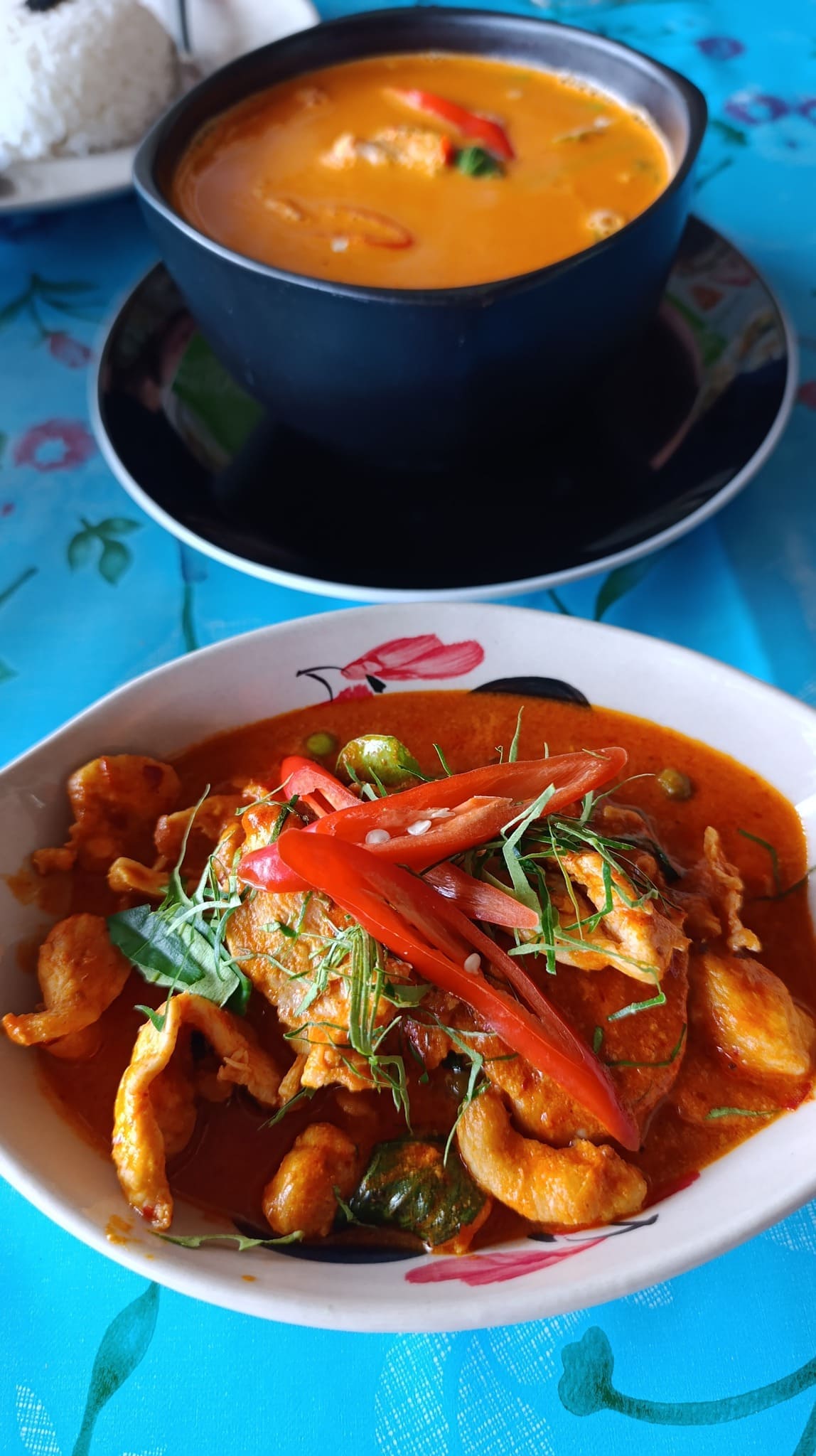

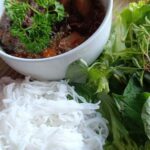
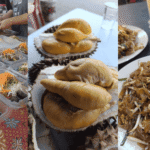








Leave a Reply